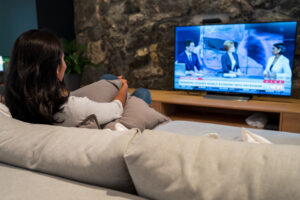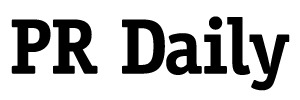Don’t touch that dial: Using radio in PR
Tune in and see the benefit of PR pros using radio to tap into new markets and boost brand visibility.

Listening to the radio is still the “in” thing to do.
Even younger segments of the population keep this oldie-but-goodie form of entertainment in their time-passing repertoire, too.
According to Nielsen Reports, 93% of American adults tune in to radio programs (and other audio mediums) throughout the month.
Also, a majority of terrestrial radio listeners opt to get their news, music and entertainment by tuning in to the radio versus endlessly scrolling on social media, Musical Pursuits reported. To be exact, 293 million Americans listen to the radio in comparison to 180 million Facebook users, according to Musical Pursuits.
Listening to broadcast radio reaches 87% of Gen Zs every month and cuts across all demographics who consistently listen in.
Nielsen also reports that more people are listening to the radio and fewer people are watching TV, Inside Radio notes. According to Nielsen, broadcast radio garnered a 3% higher average audience than TV among persons 18-49 years during the 2022 third quarter.
“We are seeing media history being made right before our very eyes,” says Cumulus Media Chief Insights Officer Pierre Bouvard in the article. “That has never happened before.”
Nielsen notes that broadcast radio reaches many segments of the population, too, broadly reaching Black people and Hispanics.
While listeners are partaking in the joys of radio, PR professionals should also think about using it to increase their brand, relay messages and cost-effectively discover a wider audience.
That means pitching to broadcast journalists can be an integral part of a PR pro’s arsenal for reaching audiences, including audiences who are often underserved.
Eric Jon Magnuson, director of Production and Marketing at North American Network (NAN Radio) says it’s cheaper to pitch to radio stations, too.
“Production costs for radio remain a lot less than those for a newspaper or TV. And TV stations still tend to focus on their immediate vicinity, often neglecting outlying areas,” Magnuson said. “Radio is a flexible medium, as you don’t need a traditional receiver; from smart speakers to smartwatches, more and more devices allow for listening in all environments,” Magnuson said, adding that radio can have a “unique role” in providing news to regions that might not otherwise receive it.
On the ad front, radio ads stand tall among the competition, according to an audio-based listening survey from Edison Research’s quarterly “Share of Ear” study.
Edison Research, which surveyed 4,000 Americans to gauge their audio interests, found that AM/FM radio takes the lion’s share of “ad-supported audio” with a 73% share of time spent among people 18 and up, according to the survey takeaway from Westwood One. Podcasts take a distant second, garnering a 15% share.
Tammy Lemley, NAN Radio vice president of Business Development, attributes radio’s enduring success to its uniqueness from other forms of media.
“When you’re listening to the radio, it engages your mind in a unique way. One of the things that I love about radio is that it’s live and local. It’s an excellent way for people to connect with their community,” Lemley said.
Lemley adds that listening to the radio is not a heavy lift because one can participate in multiple activities like being in the car, at home, walking the dog and more.
“It’s very portable,” she said. “It goes where you go. And people are listening in a greater variety of ways. Today, you know, they’re listening via the regular radio, but they’re also listening on their smartphones or listening on their computers.”
Radio listening experiences are also hyper-local, which makes for greater targeted messaging for PR professionals looking to relay a message for their brand or communicate something else important, Lemley adds.
“There’s really something for everyone on the radio and from a public relations point of view as a PR practitioner everyone should have radio in their communications toolbox. If you don’t, you’re leaving audience on the table,” Lemley said.
Sherri Kolade is a writer at Ragan Communications. When she is not with her family, she enjoys watching Alfred Hitchcock-style films, reading and building an authentically curated life that includes more than occasionally finding something deliciously fried. Follow her on LinkedIn. Have a great PR story idea? Email her at sherrik@ragan.com.
COMMENT
2 Responses to “Don’t touch that dial: Using radio in PR ”
PR Daily News Feed
RECOMMENDED READING
Tags: radio








A possible drawback is that someone high in management may ask “what is she accomplishing with her PR program,” and someone else may answer: “she got us on the radio.”
Radio can add power to a PR program but it could pay to start planning a program by thinking: “WHERE would my management most love to see media coverage ,” and “WHAT coverage would my management most love?
What is most difficult may be what would be best. Management might love to see massive coverage maybe two or three days in a row in major dailies and evening TV. It’s possible and some in PR achieve this.
Awesome could be major media saying what everyone would care about, like our management and our customers are “heroes of health” who are helping the public to live more safely, as by reducing gun violence or by helping to protect the public against cancer.
It’s possible. We may actually achieve this because right now our great universities and foundations have teams of brilliant psychologists studying WHY some people, especially young people, become mass murderers. Our great hospitals are actually finding vaccines that work against cancer, and are recruiting top doctors from all over the world to search for—and they are doing this—cancer CURES that save millions of lives.
The FDA has already licensed a limited-use cancer vaccine, and MD Anderson Cancer Center in Houston is researching to find a broader use cancer vaccine that may protect billions of people.
Thousands of doctors all over the world would love to get jobs at Memorial Sloan Kettering Cancer Center. They recently formed in New York a research team under extraordinary Dr. Prioty Islam to attack MDS (myelodysplastic syndromes). Success could lead to reduction or defeat of leukemia which has killed millions.
If a company sponsors MD Anderson or Memorial Sloan Kettering and
the announcement team—top doctors and corporate executives–announces a research push to try saving 100 million lives, can you imagine the massive media coverage worldwide?
Radio can add power to a program. So can the wisdom in PR Daily courses on crisis PR and media communication. Aided by the wisdom of courses, a good way to begin making PR choices is by thinking of (a) what can do one’s company the most good and (b) how can we get there.
The courses and your planning choices could help bring PR results that get top management to say, “Ooo, this one is a winner!”
A wise first step could be to not only invite North American Network in for a talk but to comply with what these experts suggest. Even the best medicine works only if you take it.